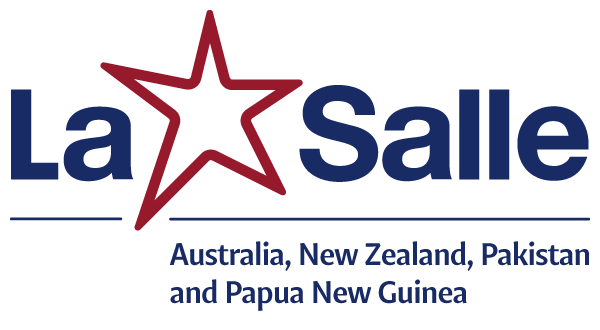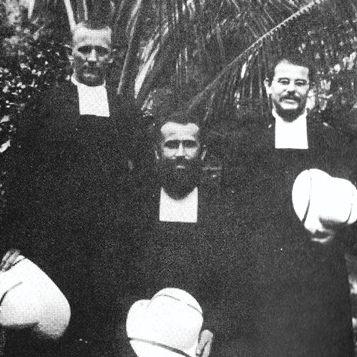The German De La Salle Brothers in “New Guinea” 1914-1921
It was a time of great instability and feverish defence preparations on the European continent, as nations were still stamping their colonial influence and ownership on many other parts of the globe. The year was 1914, with the explosion of a titanic struggle for nationalist supremacy in the First World War. It also saw five De La Salle Brothers of the German Empire arrive in “New Pomerania” (current New Britain) to start a small multi-ethnic boys’ school, in the then flourishing Catholic Vicariate in Melanesia.
The Trip to Melanesia
In October 1913, their superior farewelled them at Strasbourg, they promising to “do our utmost to esteem and love our Rule, and to remain at all times true sons of our Founder”. Thus said Br Viktorinus, 43 and the Director. Links to home on the 7-month journey on the “Roon” from Genoa came with the issue of 10 postcards given to each. These were sent from the ship or points of call -Port Said, Colombo, Fremantle, and finally Sydney. Experiences included meeting other Brothers teaching in Pt. Said and Colombo, suffering from the ‘red dog’ (skin irritation) in the Tropics, ship-evacuation practice, and drenching games by Neptune at the Equator.
Each spruced out with a supply of five new white suits, they were on board with compatriot German priests and brothers -Missionaries of the Sacred Heart (MSC) - also heading to New Britain where the Kaiser’s colonial “Protectorate” (established 1884) included two successful Catholic German missions, under the formal Church Vicariate of an indomitable Mons. Louis Couppé.
The Mission and New Venture
This enterprising churchman, in Vunapope, worked harmoniously with the German authorities who had under their control an expatriate European population of 1,000 Germans, and in Rabaul up to 700 whites, Chinese and Malays.
The Vicar bought up land - 32,000 acres - to produce copra and coconuts. The solid roots of the mission in a Melanesian colony can be judged by the large Catholic community of MSC Fathers (44) and Brothers(37), two communities of European Sisters (34) and 31 indigenous Sisters. The school population was close to 4,000.
Couppé (later Bishop) had “a school for catechists, a boarding school, a technical school, orphans’ houses and a school for mixed-race children…by 1914 there were 135 schools with 4,825 pupils…German was taught in all schools where missionaries were teachers”, says the Encyclopedia of PNG (1972).
So, the Brothers, persistently requested over the years by the Monsignor, were to start teaching about 50 boys of mixed blood. In the whole Protectorate there were 280. These more marginalised youth were to be the beneficiaries of the Brothers who arrived on Easter Sunday, 12 April 1914. A school for mixed races had existed for 16 years previously under French Sisters. The surmise was that the administration may have urged that German and male nationals, be teachers for teenage boys. (The Sisters were already running such a school). Couppé envisioned educated mixed-race youth to be a nucleus for a Christianizing influence in the German mission.
The actual school of the Brothers was a peculiar set-up. “The pupils were housed in a barracks. In rainy weather no dry place could be found. During the hot weather, the frightful heat was almost unbearable. The interior consisted of but one room, which served at the same time as classroom, dormitory and refectory. The school furniture was very primitive” (anonymous correspondent). The boys, however, were willing to learn and docile. The curriculum was elementary, including singing and many favoured manual subjects. They learnt German, and spoke Pidgin. Most were boarders, as their parents lived and worked on distant islands or plantations.
Profile of the Brothers
What of the teaching Brothers? Br Lucian Thorpe, a later longtime PNG missionary, interviewed a Mr. Zander who had worked on the mission and described Br Viktorinus Brueggemann as “middle-aged, tall, well-built, a capable administrator and popular with both community and people.” Yet, within 7 months he had died- on 21 November 1915.
Seemingly, he had had several bouts of malaria, and with the development of a malignant ulcer operated on by a doctor he deteriorated. Deeply distressed, the community formed a long funeral procession to the mission cemetery, where his grave, to this day, is marked by a prominent headstone. The Brothers’ Roman headquarters spoke of a highly esteemed confrere, and a skilled teacher of 15 years.
Presumably, the 27-year-old Br. Urban Hinkes, next senior, took over the leadership. He was teaching from 1908 and had done his military service in 1912. Sr. Gérard on the mission described him as “truly a father to these children who for the most part were without family…with indefatigable devotion he spent himself for them day and night…heroic…loved by all.” He was in charge of the liturgical singing and directed the choir on feast days.
Br. Hermann Hahn, 20, had temporary vows, was a tall blond man and played the organ at Masses. A similar age was Br. Otto Thalheimer, the “physical culture expert,” short and strongly-built, and “probably the most popular…in the eyes of the pupils.”
Also young, at 23, Br. Edmund Noss, was tall and dark, with a slight stoop, and in charge of the workshops. After Br. Viktorinus’ death he had a “falling out” with the three other Brothers, said a local who knew him; he left the Institute and gained employment in a local plantation, never returning to Germany.
With no Lasallian documentation for the War years, one must rely on that of the MSC Fathers, with all the German inhabitants expressing anxiety about the possibility of taking up arms against the Australian invading enemy. A note in November 1914 reported that the ‘enemy’ did no damage to the mission, and there was no need to defend territory.
Times of War
As to the “mixed-races” education, it seems that the Sisters ran a similar school for the girls, and that German was the instructional language, despite the English -speaking occupying Australians at the time. Br. Urban reported that there were 50 pupils in December 1919. While there was no mention of numbers in the “trade school,” those grand garçons demi-blanc (big lads, half-white) were probably included in the number fifty.
The only contact with a world at war beyond them were two visits – one by the Australian Visitor, Br. Paul Phelan in 1916, and a second by Br. Fridolin in 1917, by which time the community of three would no longer have anticipated a German victory.
By 1919, as New Pomerania was being ceded to Britain by the League of Nations, a tug-of-war ensued until 1921 between the revered Bishop Couppé and the Brothers’ German Visitor / Generalate. The latter wanted the immediate return of the Brothers, while Couppé fought a rearguard action to retain their services. This is recorded in voluminous correspondence quoted by Br. Christian in his history, to which this author is totally indebted for the above history.
Withdrawal and Regrets
The inevitable withdrawal from the British dependency in 1921 happened, with the Bishop noting to the Brothers’ Superior that-
“your dear Brothers since their arrival have given us the fullest satisfaction , as much by the sanctity of their lives, as by the success they have obtained in the boarding (sic) school for the half-castes which has been entrusted to them.”
He asked for a new contract for more Brothers who could teach in English now, of course.
Generous in his praise, he highlighted the Brothers’ “affability and their tact…(making) themselves all things to all people, maintaining peace and concord with everyone”, indicating perhaps the ups and downs of mission life, and the possible tensions with locals or mission priests, who would consider teaching Brothers no different in status to their own lay Brothers.
Ironically, it was the originally sickly Br. Otto who on return home, completed his studies, was assigned to several communities, then when Brothers’ schools were closed in 1936, rekindled his missionary flame to serve in Colombia, Ecuador and finally Chile, where he died in 1950, succumbing to cancer at 55 years of age .
What of the Mixed-Race School for boys? It reverted to the Sisters, then became a full primary school, and later in the 1960’s an International School with PNG students. The De La Salle Brothers – four Australians – were the next Brothers to offer education in Papua New Guinea in 1946. Bomana and Yule Island in the south were their first foundations.
Reference: Christian J. Moe FSC, A Forgotten Mission: the German De La Salle Brothers in New Guinea 1914-1921 (1986)
Author: Br Gary Wilson, District Creative Writer
- Log in to post comments

